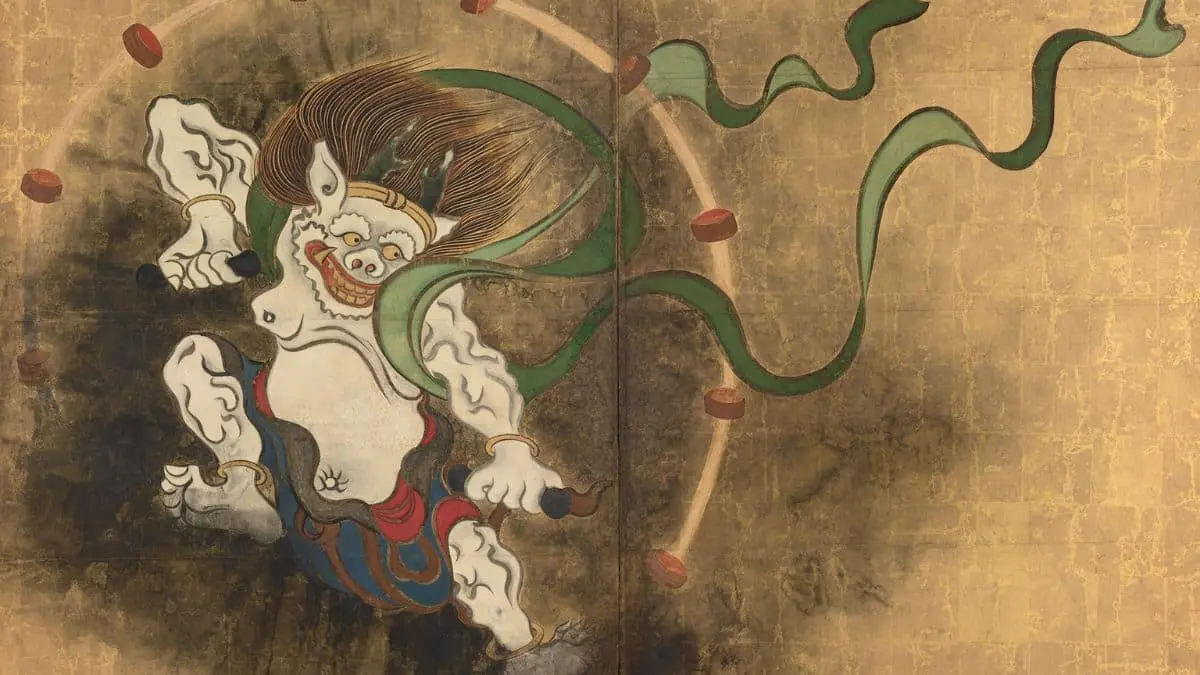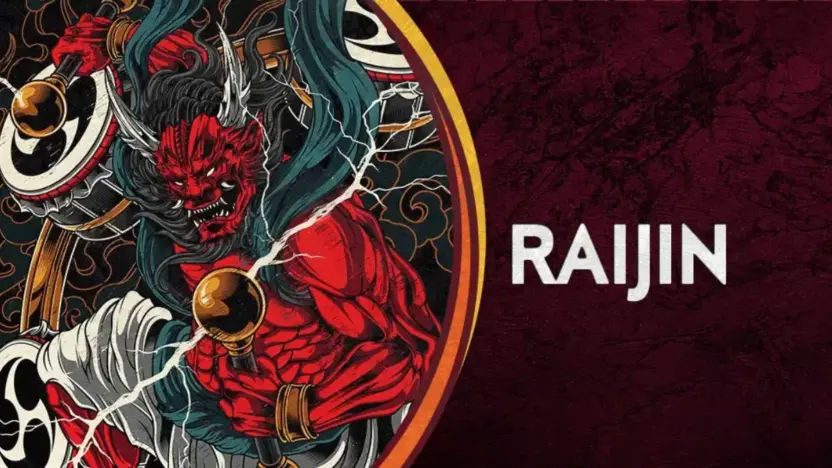When the skies darken and thunder rolls across the heavens, the Japanese don’t just see a natural phenomenon; they hear the beats of Raijin’s mighty drums. A monumental figure in mythology of Japan, Raijin is the Japanese God of Storms and Thunder, revered and feared for his tempestuous nature. Captivating the imaginations of people for centuries, he is more than just a mythical figure; he is a cultural symbol deeply embedded in the Japanese understanding of the natural world.
Raijin | Japanese God of Storms and Thunder
The Origins of Raijin
Understanding Raijin requires delving deep into the ancient texts and folklore of Japan. Though his true origins are somewhat nebulous, Raijin’s presence is felt across various religious and cultural facets of the country.
Historical Context
Raijin is an important deity in both Shintoism and Japanese Buddhism, embodying the raw, untamed force of nature. His roots are often traced back to ancient Shinto beliefs, long before Buddhism entered Japan from China and Korea. Over the years, Raijin has been seamlessly incorporated into both religious practices, reflecting the syncretic nature of Japanese spirituality.
Ancient Texts and Scriptures
Raijin is mentioned in some of the oldest Japanese texts, such as the “Nihon Shoki” and the “Kojiki,” both of which serve as historical chronicles and collections of myths. These texts not only describe Raijin but also provide accounts of his battles, victories, and the tempests he brings.
Chinese and Indian Influences
Interestingly, Raijin’s character seems to be influenced by similar deities from other Asian mythologies. For instance, the Lei Shen from Chinese mythology and Indra from Hindu mythology are both thunder gods who bear resemblances to Raijin. The similarities are not surprising, given the historical cultural exchanges between these civilizations.
Creation Myth
In some versions of the Japanese creation myth, Raijin is born from the divine couple, Izanami and Izanagi, who are responsible for creating the Japanese archipelago. As one of their offspring, Raijin is inherently tied to the natural elements of the land. He is often depicted as a sibling to Fujin, the god of wind, illustrating the close relationship between wind and thunder in the natural world.
Physical Description and Symbols
One of the most intriguing aspects of Raijin is how he is depicted in art, literature, and religious iconography. This visual characterization not only serves an aesthetic purpose but also encapsulates the essence of Raijin’s power and importance in Japanese mythology.
Physical Appearance
Traditionally, Raijin is portrayed as a fearsome, muscular deity with a demon-like appearance. His visage is intense, often featuring glaring eyes, a wide mouth, and sharp fangs. One of the most distinctive features is his drum set, referred to as “taiko” drums, which are strapped around him. It is said that Raijin plays these drums to create the sounds of thunder.
Symbols
- Drums (Taiko): Raijin’s drums are perhaps the most iconic symbols associated with him. These are the instruments upon which he pounds to create thunder, adding a layer of rhythmic complexity to the natural world.
- Thunderbolts: Often Raijin is depicted holding or surrounded by thunderbolts, emphasizing his control over storms and electrical phenomena.
- Ring of Clouds: A frequent backdrop to Raijin is a swirling ring of clouds, highlighting his dominion over storms.
Color Schemes
Artistic representations often utilize a vibrant palette to depict Raijin. Reds, blacks, and blues are common, evoking a sense of ferocity and divine power.
Clothing and Accessories
Raijin is typically depicted with minimal clothing to showcase his muscular physique, often adorned with only a loincloth. His accessories may include beads, feathers, and sometimes even small totems, all adding complexity to his fearsome demeanor.
Artistic Representations
Raijin has been featured in various forms of art, ranging from ancient scrolls and woodblock prints to modern illustrations and statues. Notably, he often appears in the famous artwork of the Edo period and has been reimagined by artists and creators for centuries.

Raijin’s Powers and Abilities
The mythological narratives surrounding Raijin are brimming with awe and respect for his incredible powers. As the God of Storms and Thunder, Raijin commands some of the most formidable forces of nature.
Control over Thunder and Lightning
- Raijin’s most famed power is his control over thunder and lightning. By beating his taiko drums, he can summon or amplify storms, sending bolts of lightning across the sky.
Mastery of Wind
- Though his brother Fujin is principally the god of wind, Raijin also exhibits some dominion over this element. In some stories, Raijin’s drumming not only brings about thunder but also whips up violent winds.
Elemental Manipulation
- Beyond merely generating storms, Raijin is believed to have the ability to control various elements, such as rain and fire. This places him as one of the most versatile and powerful gods in the Japanese pantheon.
Terrifying Roar
- Raijin’s roar is said to be as impactful as his drumming. A single shout from him can shake the heavens and terrify those who hear it.
Guardian of the Natural Order
- Despite his fearsome capabilities, Raijin is not purely a force of destruction. He is often seen as a guardian deity who maintains the natural order, balancing the elements and ensuring the cycles of nature proceed as they should.
Raijin’s Relationships and Counterparts
In mythology, no deity is an island, and Raijin is no exception. His interactions with other gods and mythological figures reveal a complex tapestry of relationships that both humanize and elevate him. Additionally, Raijin’s concept is not unique to Japan; thunder gods are a common theme in mythologies around the world.
Family Ties: Fujin, the God of Wind
- Raijin is often considered the brother of Fujin, the God of Wind. Together, they represent some of the most formidable natural forces, and their brotherly relationship embodies the interconnectedness of these elements.
Interactions with Other Deities
- While Raijin primarily interacts with Fujin in mythology, he also encounters other gods, spirits, and mythical creatures. These interactions range from collaborations to battles, each story adding another layer to Raijin’s complex character.
Raijin and the Pantheon
- Discuss how Raijin fits into the larger pantheon of Shinto and Buddhist gods. Is he considered a major deity? What kinds of rituals or offerings are typically made to him?
Cross-cultural Counterparts
- Raijin shares many characteristics with thunder gods from other mythologies, such as Thor in Norse mythology and Zeus in Greek mythology. Even within the broader context of Asian folklore, similar gods exist, like Lei Shen in Chinese tradition and Indra in Hindu lore.
Also Read: Ravana: The Ten-Headed King and His Complex Legacy in Hindu Mythology



